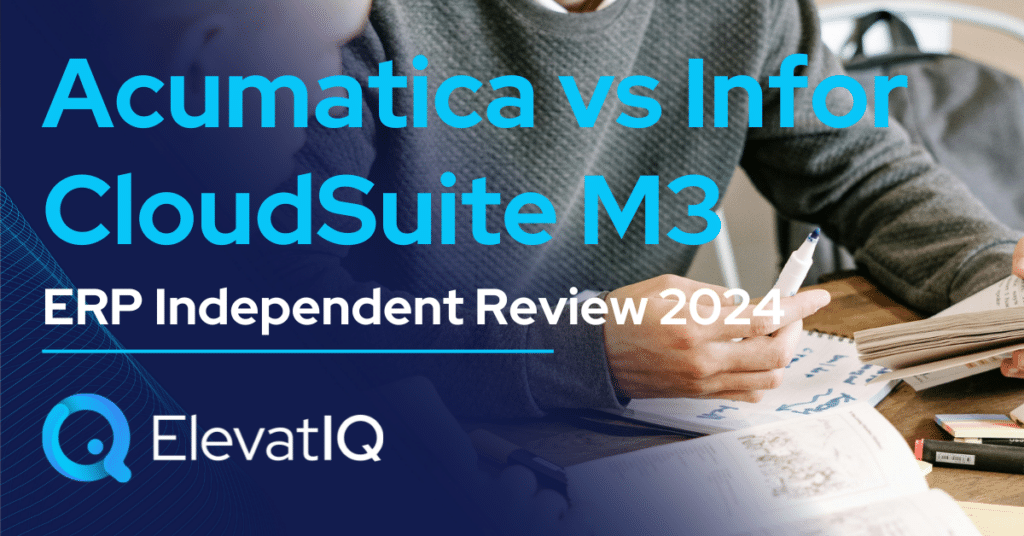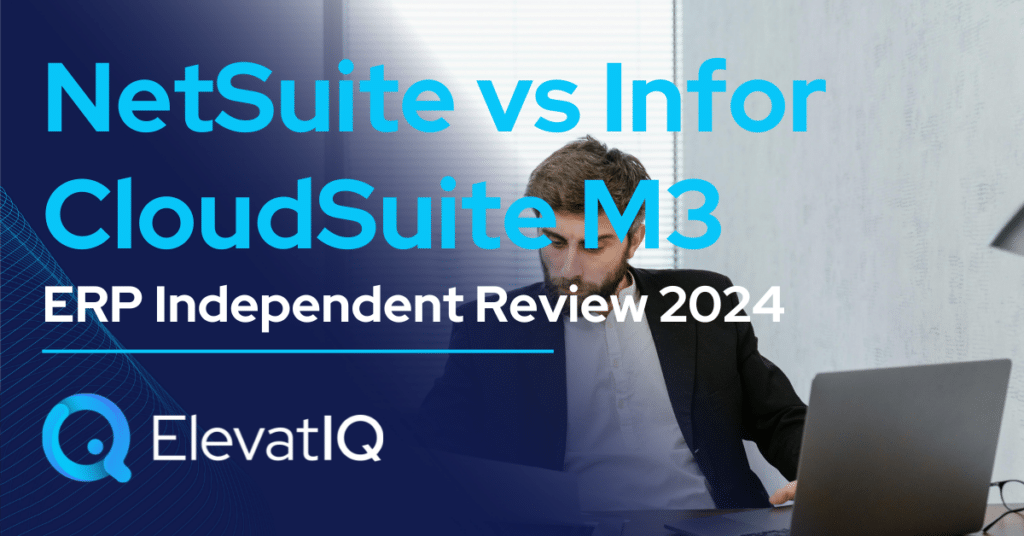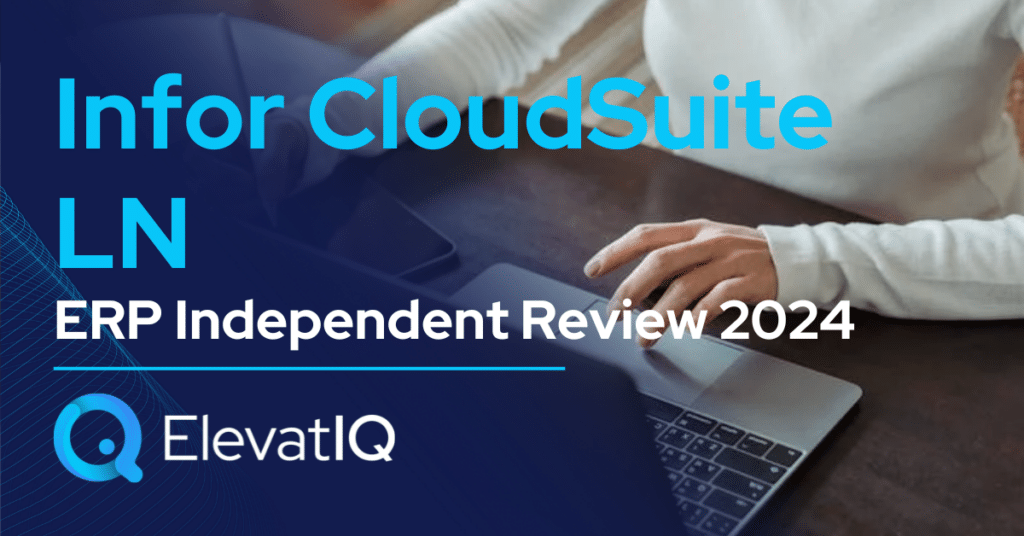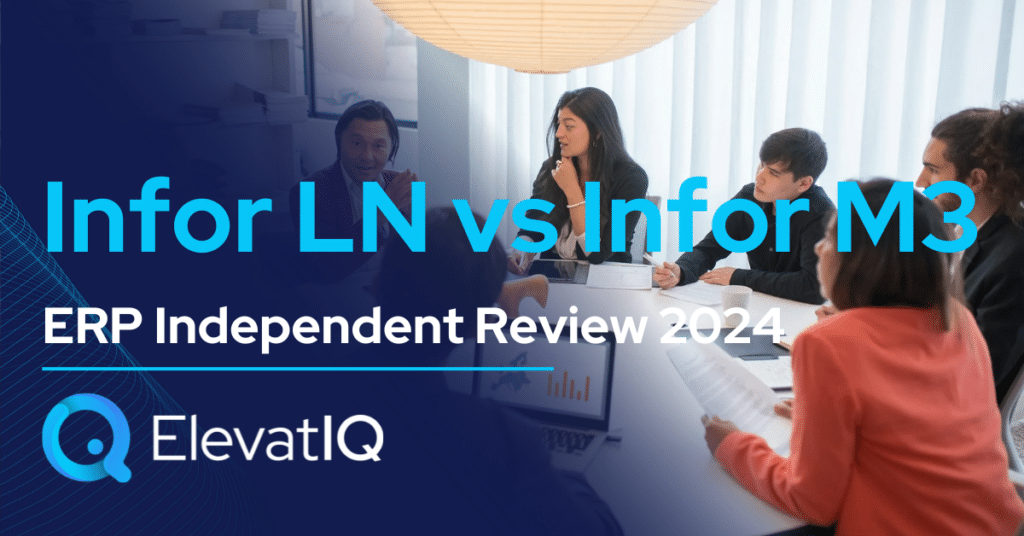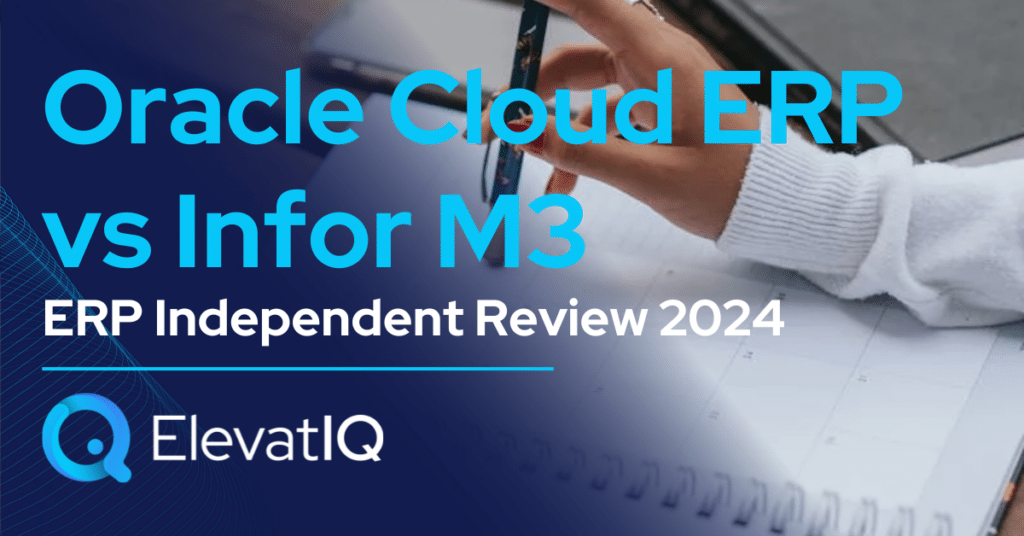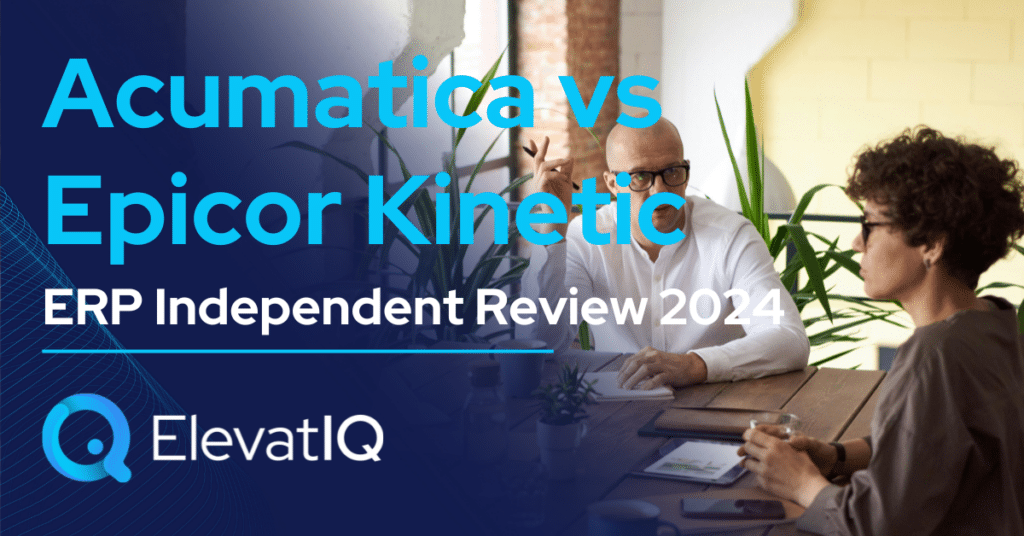Acumatica stands out among three cloud-native ERP vendors particularly focusing on small and medium-sized businesses, alongside NetSuite and Sage Intacct. On the other hand, Infor CloudSuite LN surpasses entry-level ERP systems like Acumatica, Infor CSI, or NetSuite, by delivering mature capabilities for intricate manufacturing intertwined with distribution operations. It is also successful in the upper mid-market, targeting the $250M – $750M revenue range. Acumatica, however, caters well to companies with revenues ranging from $10-100 million, offering limited native localization features yet suitable synergies for global operations.
Infor LN also provides a superior suite experience akin to SAP and Oracle, featuring enterprise-grade best-of-breed functionalities, including PLM, WMS, WFM, BI, and a supply chain collaboration platform. Whereas, Acumatica’s strength lies in its multi-branch capabilities and tailored support for various business models such as manufacturing, distribution, construction, and field service.
While Infor LN excels in discrete manufacturing and offers a robust suite experience, it does face certain challenges in specific scenarios such as with process-centric operations for companies. On the other hand, Acumatica serves as an excellent entry-level system for companies transitioning from QuickBooks or smaller point systems seeking seamless cross-functional integration. Choosing between Acumatica vs Infor CloudSuite LN requires a detailed examination, and thus, this comparison offers valuable insights for ERP selection projects. Therefore, let’s explore further.
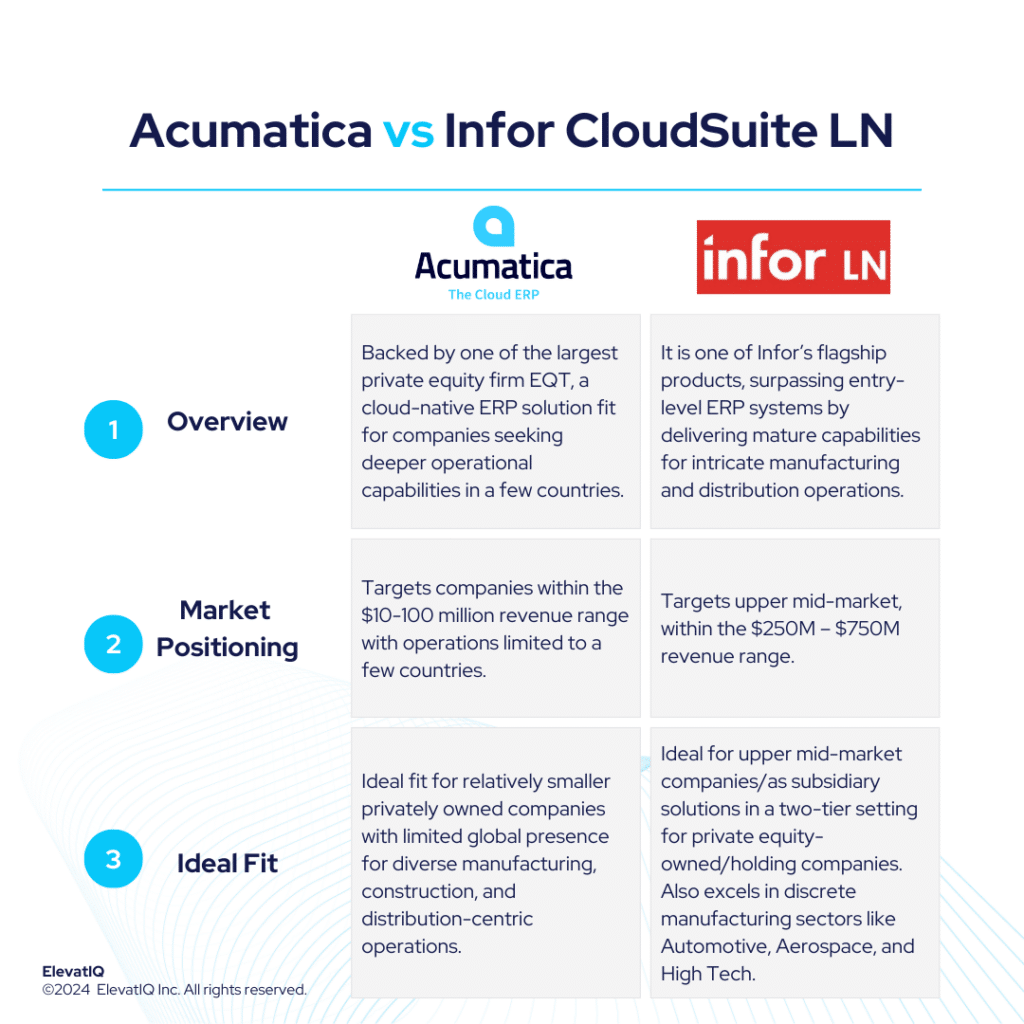

| Acumatica | Infor CloudSuite LN | |
| Started in | 2008 | 2006 (when Infor acquired BaaN) |
| Ownership by | EQT Partners in 2019 | Koch Industries |
| No. of customers | 10,000+ | 1000+ |
What is Acumatica?
Acumatica is one of three cloud-native ERP solutions particularly similar to NetSuite and Sage Intacct. It has extensive multi-branch capabilities, particularly making it friendlier for retail-centric operations. It can also host multiple business models as part of the same database spanning manufacturing, distribution, construction, and field service. Thus, making it friendlier for diverse manufacturing or distribution-centric operations. Because of its limited global operational capabilities, it primarily targets US and UK-based companies. Thus, positioned as an ideal choice for companies within the $10-100 million revenue range, the majority of Acumatica’s customer base falls under this category.
Desiring a user experience akin to Odoo or Quickbooks, Acumatica ERP also offers versatility to accommodate various business models: distribution, manufacturing, or construction-focused. Although Acumatica has limitations in mature features like dimensional inventory or allocation, it is an excellent initial system for companies looking to streamline inventory or costs. With transactional processing and some mature capabilities, such as batch transactional processing, Acumatica is positioned as a valuable choice for businesses venturing into their first or second ERP solution.
Acumatica ERP is a fit for companies seeking cloud-native experience, particularly emphasizing features like enterprise search and mobility over deeper operational capabilities. Despite its focus on small businesses, Acumatica lacks robust globalization and localization features, catering to a limited number of countries by default. This simplicity, however, benefits smaller companies by avoiding unnecessary layers of multi-entity operations. Although targeting small businesses, Acumatica ERP surpasses Odoo or Zoho with the flexibility of its data layers, necessitating consulting help for implementation. The perceived benefit of Acumatica’s pricing is also a challenge, as it’s notoriously difficult to understand and predict.
What Is Infor CloudSuite LN?
Infor CloudSuite LN is a complete product suite to meet the needs of an enterprise similar to Epicor, SAP, Oracle, or Microsoft. Infor is also perhaps the only vendor after the larger ones that has the capabilities to build best-of-breed architecture akin to SAP, Oracle, and Microsoft. In fact, Infor might have deeper capabilities than Microsoft in some areas with pre-integrated best-of-breed solutions such as Infor WFM and Nexus. Infor is also the only vendor that can provide depth in several industries while not struggling with the transactional processing requirements of large accounts.
Infor LN is ideal for discrete manufacturing companies. It is successful in the upper mid-market, targeting the $250M – $750M revenue range. Positioned for companies surpassing entry-level ERP systems like Acumatica, Infor CSI, or NetSuite, this solution delivers mature capabilities for intricate manufacturing intertwined with distribution operations. Infor LN also provides a superior suite experience akin to SAP and Oracle, featuring enterprise-grade best-of-breed functionalities, including PLM, WMS, WFM, BI, and a supply chain collaboration platform.
While Infor LN excels in discrete manufacturing and offers a robust suite experience, it does face certain challenges in specific scenarios such as with process-centric operations for companies. They might also include business operations such as plastic or chemicals as part of their automotive operations. Despite limitations in broader capabilities compared to other vanilla solutions, recent upgrades acknowledge its broader application in various automotive business models.
Acumatica vs Infor CloudSuite LN Comparison
Navigating the choice between Acumatica vs Infor CloudSuite LN is a significant decision for businesses particularly looking for operational efficiency and strategic alignment. Thus, this section delves into the comprehensive comparison of Acumatica vs Infor CloudSuite LN across various critical dimensions.
| Acumatica | Infor CloudSuite LN | |
| Global Operational Capabilities | Limited multi-entity capabilities. | Has sufficient layers of financial hierarchies and global trade compliance functionality pre-baked with products. |
| Diverse Capabilities | Operationally rich for smaller companies. | Limited focus on certain business models. |
| Best-of-breed Capabilities | Limited, relying on third-party add-ons. | HCM, PLM, data lake, ERP, WMS, TMS, and advanced supply chain planning, are all pre-integrated with LN. |
| Last-mile Capabilities | May require add-ons for specific micro-verticals. | Last-mile capabilities along with breadth of capabilities for diversified manufacturing business models. |
| Operational Functionalities | Emphasizes cloud-native experience but offers deeper operational capabilities and integration for smaller operations in fewer countries. | Infor LN is a legacy solution with limited cloud-native capabilities such as universal search, mobile experience, etc. |
| Integration Capabilities | Natively-integrated WMS functionality, lacks pre-integrated best-of-breed CRM, supports only embedded CRM. | Most tools that a manufacturer would require, such as HCM, PLM, data lake, ERP, WMS, TMS, and advanced supply chain planning, are all pre-integrated with LN. |
| Manufacturing Capabilities | Suitable for light manufacturing, limited mature capabilities such as allocation and Kanban. | This solution delivers mature capabilities for intricate manufacturing and distribution operations. |
| Pricing Model | Consumption-based, named, and concurrent but requires long-term contracts. | Subscription-based |
| Key Modules | 1. Financial Management 2. Construction Management 3. CRM 4. Distribution Management 5. Service Management 6. Manufacturing Management 7. Project Accounting Management 8. Payroll 9. Retail e-Commerce Management 10. Reporting, Dashboard and BI | 1. Financials 2. Human Resources 3. Manufacturing Management 4. Inventory Management 5. Purchasing Management 6. Quality Management 7. Sales Management 8. Product Technology |
Acumatica vs Infor CloudSuite LN Feature Comparison
Both platforms offer a plethora of features and functionalities designed to streamline business operations and enhance efficiency. In this feature comparison, we delve into particularly the distinct capabilities of Acumatica vs Infor CloudSuite LN across various critical dimensions, providing insights to aid businesses in making informed decisions regarding their ERP selection. Thus, this section discusses features under each of the following modules, particularly financial management, supply chain management, and manufacturing management.
Financial Management Comparison
In this section, we are discussing a detailed comparison of the financial management capabilities particularly offered by Acumatica vs Infor CloudSuite LN. By examining their respective strengths and functionalities, particularly in managing financial processes. Businesses can therefore gain valuable insights to determine the best-suited ERP solution for their financial management needs.
| Acumatica | Infor CloudSuite LN | ||
| Financial Management | General Ledger | Designed to support ledgers limited to support one country. Limited multi-ledger capabilities. | The General Ledger is the core component of Infor LN Financials, recording all transactions within the application that affect accounting. |
| Accounts Receivable and Accounts Payable | The AR and AP might be limited to just one country with limited synergies among vendors from different countries. | AR manages customer invoices and credit, while AP handles supplier invoices and balance management. | |
| Cash Flow Management | Manages day-to-day transactions, cash balances, funds transfers, and bank account reconciliations for smaller operations. | Provides comprehensive forecasting, analysis, and Azure ML-based prediction of cash inflows and outflows. | |
| Currency Management | Creates estimates for new or existing items, convert to bills of material, production orders. | The LN multicurrency systems allow a company to conduct accounting in multiple currencies, calculating and registering amounts in up to three currencies. | |
| Tax Management | Provides centralized tax configuration, management, and reporting. | Tax reporting is part of financial accounting and is limited to one country, so LN’s tax handling in a multicompany structure is similar to that in a single company environment. |
Supply Chain Management Comparison
In this comparison, we explore and analyze the supply chain management capabilities of Acumatica vs Infor CloudSuite LN, shedding light particularly on their respective strengths and weaknesses.
| Acumatica | Infor CloudSuite LN | ||
| Supply Chain Management | Warehouse Management | Provides real-time inventory visibility and streamlines warehouse operations. | Warehousing focuses on managing and replenishing goods within a warehouse, including tasks to report and analyze inventory movements. |
| Service Management | Enables quick service needs capture, assignment, and real-time tracking, with features like contract management and appointment schedules. | Manages the maintenance, repair, and overhaul of field-based and plant-based products, equipment, and systems. | |
| Inventory Management | Simplifies inventory processes with flexible item management and quality traceability. | Can support complex inventory types including dedicated inventory masters for MRO or quality components for added granularity and control | |
| Purchase Order Management | Streamlines procurement processes with policy enforcement and process controls. | Can create and modify purchase orders for purchasing goods. | |
| Sales Order Management | Centrally manages sales activities and tracks prices and inventory. | They are utilized to sell and deliver items or services to a sold-to business partner under specific terms and conditions, originating from various sources like Contracts, Quotations, EDI, and Planning. | |
| Requisition Management | Organizes complex distribution processes involving multiple products and suppliers. | Specifies nonsystem planned requirements for different types of items, including inventory items, cost items, and service items. |
Manufacturing Management Comparison
In this comparison, we explore and analyze the manufacturing management capabilities of Acumatica vs Infor CloudSuite LN, shedding light, particularly on their respective strengths and weaknesses.
| Acumatica | Infor CloudSuite LN | ||
| Manufacturing Management | Production Planning | Assists manufacturers in addressing production demand with the agility to adjust to fluctuating schedules, unforeseen equipment malfunctions, delayed deliveries from suppliers, and other unexpected occurrences affecting operations on the factory floor. | One of the most robust production planning capabilities including advanced planning and scheduling capabilities for diverse manufacturing operations |
| BOM and Routing | Lets you efficiently plan and manage inventories, costs and manufacturing processes. | It is stored as general item data for LN in Item Production Data (IPD). | |
| Advanced Planning and Scheduling | Lets you create a more streamlined and accurate production scheduled, better enforce delivery dates and optimize for capacity. | Stores scheduling information for projects, allowing you to define project plans along with associated activities and milestones. |
Pros of Acumatica vs Infor CloudSuite LN
When evaluating ERP solutions, understanding the distinct advantages of Acumatica vs Infor CloudSuite LN is crucial. In this section, we are particularly exploring the strengths of Acumatica vs Infor CloudSuite LN across various dimensions. Thus, shedding light on their respective capabilities and functionalities.
| Acumatica | Infor CloudSuite LN |
| Great 1st or 2nd ERP choice particularly due to limited layers and mature capabilities for larger companies. | Ideal for upper mid-market companies or as subsidiary solutions in a two-tier setting for private equity-owned or holding companies. |
| Accommodates different business models spread in fewer countries under one database. | It can support the most complex manufacturing business models, WBS-centric manufacturing, or support for attributes with MRP planning. |
| Great fit for SMB B2B businesses with complex product mixes. | Most tools that make-to manufacturer would require, such as HCM, PLM, data lake, ERP, WMS, TMS, and advanced supply chain planning, are all pre-integrated with LN. |
| Born in the cloud with consistent design principles across the application. | While most smaller solutions might require ad-hoc arrangements for global financial operations, Infor CloudSuite LN has them natively built. |
Cons of Acumatica vs Infor CloudSuite LN
Just like recognizing strengths is important, it’s also crucial to weigh the specific drawbacks of Acumatica vs Infor CloudSuite LN. Therefore, in this section, we will delve into the limitations and challenges associated with Acumatica vs Infor CloudSuite LN across various operational and financial dimensions.
| Acumatica | Infor CloudSuite LN |
| Limited capabilities when multiple countries with different currencies and sub-ledgers need to be hosted as part of the same solution. | The limited focus on certain business models poses the risk of requiring other ERP systems to support complex and diverse business operations such as process manufacturing or metal-centric A&D companies. |
| Not fit for companies with over $100 million in revenue. | Private equity and holding companies requiring global solutions with a tier-2 solution at the subsidiary level might not be the best use of Infor LN’s strengths. |
| The mobile capabilities are leaner for complex reporting scenarios such as parallel processing or reporting labor. | Infor LN is a legacy solution with limited cloud-native capabilities such as universal search, mobile experience, etc |
| Consumption-based pricing requires consulting expertise to estimate transactions as the pricing is not as predictable. | The consulting base and marketplaces are virtually non-existent for Infor LN. |
| Multiple add-ons such as MES, PLM, and quality, posing integration and communication challenges with the core systems required for complex manufacturing. | The integration of Infor LN with MES enhances its capabilities, particularly in complex manufacturing processes. |
| The last-mile capabilities required for manufacturing or industrial distribution may not as strong as purpose-built solutions such as Infor or Epicor but comparable to vanilla solutions such as SAP S/4 HANA. | Verticals such as automotive manufacturing demand deeper integration of PLM, CAD, and vendor portals to effectively manage their unique processes. |
Conclusion
In conclusion, Acumatica emerges as a compelling choice among cloud-native ERP vendors, catering particularly to small and medium-sized businesses with its versatile capabilities. Positioned alongside NetSuite and Sage Intacct, Acumatica offers flexibility and multi-branch support, making it ideal for companies with revenues ranging from $10-100 million. However, it falls short in providing robust global operational features, limiting its suitability for companies with expansive international operations.
On the other hand, Infor CloudSuite LN surpasses entry-level ERP systems, offering mature capabilities tailored for intricate manufacturing and distribution operations. With a suite experience akin to SAP and Oracle, Infor LN delivers enterprise-grade functionalities across various modules such as PLM, WMS, WFM, and BI. While it excels in discrete manufacturing, it may face challenges in certain scenarios, particularly with process-centric operations.
Ultimately, the choice between Acumatica vs Infor CloudSuite LN hinges on a detailed examination of business requirements and operational needs. Both solutions offer distinct advantages and limitations, making this comparison an invaluable resource for organizations embarking on ERP selection projects. Thus, further exploration and evaluation are essential to determine the best-fit ERP solution for a company’s unique needs. Also, seeking assistance from an independent ERP consultant can significantly aid the decision-making process, offering specialized advice and direction tailored to the specific needs of the business.




